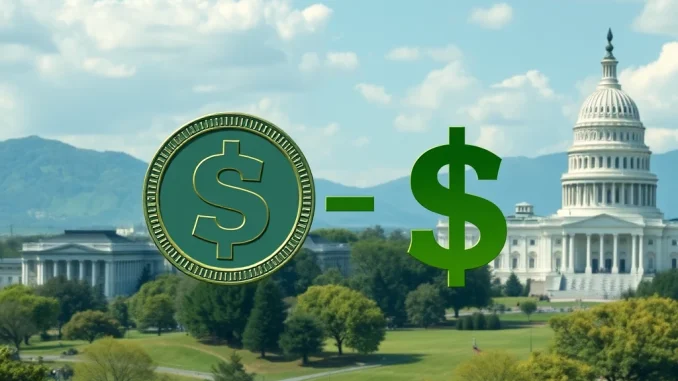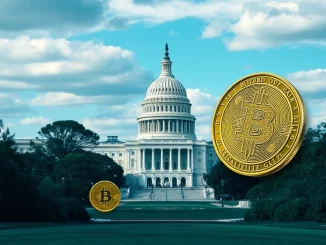
The world of digital assets is constantly evolving, and sometimes, insights from unexpected corners highlight their growing importance. For those tracking the intersection of cryptocurrency and traditional finance, a recent statement from a high-ranking U.S. official is particularly noteworthy. U.S. Treasury Secretary Scott Bessent has weighed in on the potential impact of Stablecoins, suggesting they could play a significant role in reinforcing the dominance of the US dollar supremacy on the global stage. This perspective offers a fascinating glimpse into how government figures are beginning to view these digital assets not just as a regulatory challenge, but potentially as a strategic advantage.
Why Does the US Treasury See Opportunity in Stablecoins?
Secretary Bessent’s comments, reported by The Block, indicate a recognition of stablecoins’ potential economic power. The core idea is that stablecoins, which are typically pegged 1:1 to fiat currencies like the U.S. dollar, require significant reserves to maintain their stability. A common and reliable asset for these reserves? You guessed it: U.S. Treasurys.
Here’s a breakdown of the key points:
- Reserve Requirements: Many stablecoin issuers hold reserves in safe, liquid assets to back the value of their tokens.
- US Treasurys as Reserves: U.S. Treasury securities are considered among the safest and most liquid assets globally.
- Potential for Demand: As the stablecoin market grows, the demand for these reserve assets, particularly U.S. Treasurys, could increase substantially.
This increased demand could translate into stablecoin issuers becoming major buyers of U.S. government debt, effectively providing a new, potentially large, source of funding for the U.S. government and further entrenching the role of the dollar and U.S. financial instruments in the digital economy.
Scott Bessent’s View: A Shift in Perspective?
The statement from Scott Bessent is significant because it comes from within the U.S. Treasury, an institution heavily involved in managing the nation’s finances and shaping economic policy. While much of the official discourse around crypto has focused on risks and the need for crypto regulation, Bessent’s comments highlight a potential benefit – the strengthening of the dollar’s global position.
This doesn’t mean regulatory concerns disappear. In fact, robust regulation is often seen as necessary to build the trust and stability required for stablecoins to achieve widespread adoption and fulfill this potential role. However, framing stablecoins as a tool that could bolster the dollar’s status adds a new dimension to the policy debate.
Stablecoins and Global Dollar Supremacy: The Connection
The U.S. dollar has long been the world’s primary reserve currency and the dominant currency for international trade and finance. Stablecoins, particularly those pegged to the dollar, essentially extend the reach of the dollar into the digital realm. They offer a digital form of value that is less volatile than other cryptocurrencies but retains the ease of digital transfer.
If dollar-pegged stablecoins become widely used for cross-border payments, remittances, or even as a store of value in digital ecosystems globally, it increases the functional use and demand for the underlying dollar. This, combined with the potential for stablecoin reserves to flow into the US Treasury market, creates a reinforcing loop that could solidify the dollar’s position against potential challenges from other currencies or alternative digital assets.
What Are the Implications?
Secretary Bessent’s perspective suggests a future where stablecoins are not just tolerated but potentially leveraged by the U.S. government to serve national economic interests. Key implications include:
- Policy Focus: Expect future regulatory discussions to perhaps balance risk mitigation with fostering environments where dollar-pegged stablecoins can thrive responsibly.
- Market Impact: Increased demand for Treasurys from stablecoin issuers could influence bond markets.
- Innovation: The potential for official endorsement could spur further innovation in the stablecoin space.
Of course, challenges remain, including ensuring consumer protection, preventing illicit finance, and establishing clear regulatory frameworks. But the acknowledgement from a Treasury official that stablecoins could be a net positive for dollar supremacy is a notable development in the ongoing story of crypto integration into the global economy.
Conclusion: Stablecoins as a Strategic Asset?
Stablecoins are no longer just a niche crypto product; they are increasingly being discussed in the context of global finance and national economic strategy. Scott Bessent‘s comments from the US Treasury underscore a growing recognition that these digital assets, if properly regulated, could become valuable tools for reinforcing US dollar supremacy and providing significant demand for US Treasury securities. While the path forward involves navigating complex crypto regulation, this positive outlook from a key official highlights the potential for stablecoins to become an integrated and beneficial part of the global financial landscape, anchored firmly to the U.S. dollar.



